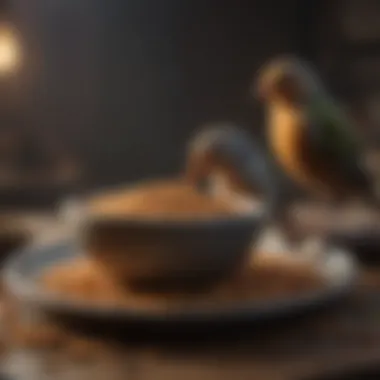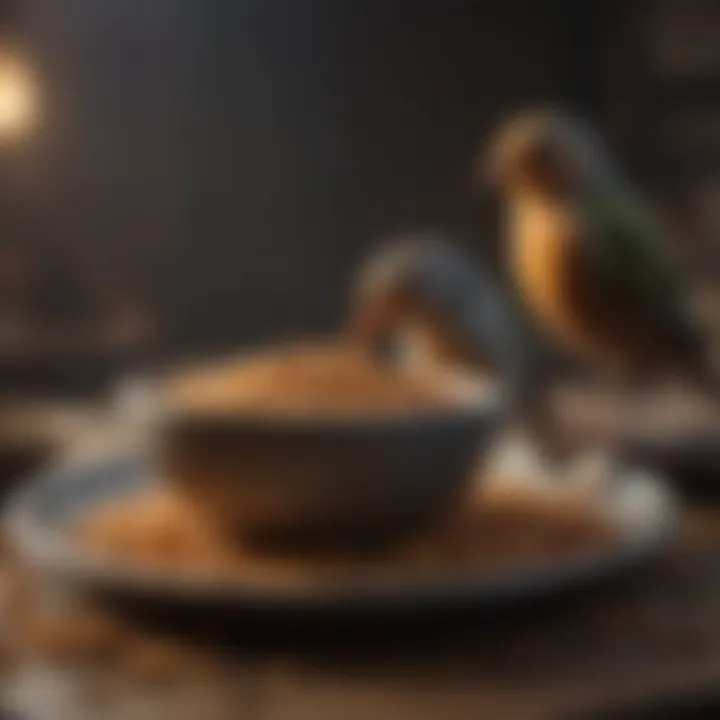Bird Basics: Essential Insights for Avian Care


Intro
Bird ownership offers unique joys but also necessitates a profound understanding of avian needs. Pet birds are more than just companions; they require careful attention to their distinct biology and behavior. This article aims to provide comprehensive insights and practical guidance, assisting pet owners in nurturing their feathered friends by addressing diet, habitat, social interactions, and overall care strategies.
Understanding Your Pet
Pet Behavior Basics
Understanding the behavior of birds is crucial for any pet owner. Birds are inherently social creatures, often living in flocks in the wild. They communicate through a variety of vocalizations and body language. Recognizing signs of stress or contentment can be vital for their well-being. Parrots, for example, may exhibit behaviors like feather plucking when stressed.
Common Breed Characteristics
Different bird species exhibit distinct traits. For instance, cockatiels are known for their friendly nature and whistling abilities, while budgerigars are active and playful. Knowing these characteristics helps in tailoring care to each bird's needs. Understanding these differences enhances the bond between the owner and the pet.
Species-Specific Needs
Every species has unique requirements. Larger birds like macaws require ample space and mental stimulation, while smaller species may need less. It is important to research each type to ensure appropriate care. Essential factors include cage size, diet, and social interactions.
Pet Care and Maintenance
Feeding Guidelines
Proper nutrition is key to an avian's health. Diet should be varied, including seeds, pellets, fruits, and vegetables. Specific dietary needs vary among breeds. For instance, cockatoos benefit from high-fat seeds, whereas finches thrive on high-fiber diets. Always consult a veterinarian to determine the best diet for your bird.
Grooming Essentials
Grooming helps maintain a bird's health. Regular nail trimming is important to prevent overgrowth and injury. Feather care is also necessary; baths or misting can help keep feathers clean and healthy.
Hygiene Practices
Maintaining a clean environment is crucial. Regularly clean cages to prevent diseases and parasites. Fresh water should be available at all times. Monitor for signs of illness, as early detection can often lead to successful treatment.
Training and Development
Basic Commands and Skills
Training birds in basic commands is essential for their development. Simple commands such as "step up" can create a strong bond and improve the pet's behavior. Consistency and patience are key in the training process.
Behavioral Training Techniques
Using positive reinforcement, such as treats and praise, encourages good behavior. It is effective for managing behaviors like biting or excessive screaming. Understanding avian psychology makes for more effective training methods.
Addressing Common Behavior Issues
Common issues include screaming or feather plucking. Identifying triggers can help in managing these behaviors. Providing enough mental stimulation and social interaction typically reduces anxiety-related problems.
Health and Wellness
Routine Vet Check-ups
Routine veterinary visits are essential to prevent health issues. Avian veterinarians can provide insights into specific breed needs. Regular check-ups help monitor weight and other vital statistics, which are indicators of a bird’s overall health.
Vaccination Needs
Just like other pets, birds require certain vaccinations. Research which vaccinations are necessary for the species you own. Keeping records of vaccination history is also recommended.
Recognizing Signs of Illness
Birds are adept at hiding illness until it becomes severe. Owners should watch for changes in behavior, appetite, or droppings. Common signs that require veterinary attention include lethargy or changes in feather quality.
Enrichment and Activities
Indoor vs. Outdoor Activities
Providing adequate enrichment is vital for a bird's mental well-being. Indoor activities might include perches, swings, and climbing structures. Outdoor time can provide fresh air and natural stimuli but must be supervised to ensure safety.
Interactive Toys and Games
Rotating toys and introducing new challenges keeps a bird mentally stimulated. Interactive toys encourage play and exploration, which can prevent boredom.
Socialization Opportunities
Birds are social by nature. Regular interactions with their owners or other birds are essential. Socialization fosters emotional well-being and reduces stress levels, making a happier, healthier pet.
"Understanding your pet bird requires effort, but the rewards of a happy, healthy avian companion are worth it."
By mastering the basics of avian care, owners can create a thriving environment. The knowledge offered here lays the groundwork for building a meaningful relationship with pet birds.
Foreword to Bird Basics
Understanding avian care is essential for anyone considering a pet bird or already owning one. Birds, unlike traditional pets such as dogs or cats, come with unique biological and behavioral needs that require special attention. Owning a bird can be rewarding or challenging depending on how well the owner understands these needs. Therefore, it is crucial to grasp the fundamentals of avian care to ensure a healthy and enriching life for the bird.
Knowledge of bird behavior, anatomy, diet, and habitat requirements directly impacts their well-being. Pet owners must recognize the complexity of bird social structures and communication methods. The more informed a bird owner is, the better care they can provide, leading to joyful interactions between the bird and its human companions.


Understanding Avian Diversity
Birds are among the most diverse groups of animals on the planet, with thousands of species each exhibiting distinct traits. This diversity is not just in their appearances but also in their behavior, habitat preferences, and care requirements. For instance, parrots, finches, and canaries all have different social and dietary needs, making it vital for potential bird owners to research the specific species they are interested in.
Recognizing the variety in bird species affects how owners will design habitats and feeding routines. Some birds are more social and require more interaction, while others might be content with minimal interaction. Understanding these differences can prevent common pitfalls in bird ownership.
Birds as Companions
Birds have proven to be rewarding companions for many households. They offer unique interactions that differ from typical pets. Their vocal and non-vocal communication can foster strong bond between the owner and the bird. For many, the joy of owning a bird is in their playful antics and the challenges of teaching them to mimic sounds or perform tricks.
However, with companionship comes responsibility. Owners must dedicate time to socialization and training to keep the bird stimulated and happy. Understanding a bird's emotional and social needs is essential, as neglect in these areas can lead to behavioral issues such as aggression or excessive vocalization.
Anatomy of Birds
Understanding the anatomy of birds is crucial for any bird owner or enthusiast. A bird's physical structure affects not only its behavior but also its health and overall interaction with its environment. By recognizing the various anatomical features, caregivers can provide better care, meet the specific needs of their birds, and create a more conducive living environment.
Physical Structure
Wings and Feathers
Wings and feathers are more than just the means for a bird to fly. They play a vital role in temperature regulation and protection against environmental elements. Feathers insulate a bird's body, helping maintain a stable body temperature. Additionally, their textures can serve as camouflage or attraction tools during mating seasons. The most notable characteristic of feathers is their lightweight nature combined with strength, a feature integral to a bird's ability to soar through the air. This unique quality not only aids in their movement but also enhances their adaptability in various habitats.
However, the upkeep of feathers is essential; bird owners must ensure their pets can preen and care for their plumage to keep it in good health. The molting process can be demanding for birds, and recognizing signs of stress during this period can be beneficial.
Beak Shapes and Functions
Each bird species has a beak shaped for its specific dietary needs and feeding habits. The diversity of beak shapes indicates the variety of diets across the avian world. For instance, parrots have strong, curved beaks designed for cracking nuts, whereas hummingbirds possess long slender beaks suitable for extracting nectar from flowers.
The primary characteristic of beaks is their ability to function as tools for feeding, grooming, and social interaction. Birds use their beaks to forage and manipulate their environment. A unique feature of bird beaks is their growth rate; they continuously grow throughout a bird's life. This characteristic highlights the importance of providing appropriate materials for beaks' wear. Not ensuring proper beak care can lead to issues such as misalignment or overgrowth, affecting the bird's ability to eat and function normally.
Legs and Feet Adaptations
The adaptations seen in birds' legs and feet reflect their habitats and lifestyles. For example, wading birds like herons have long, slender legs to navigate through wetlands, while perching birds possess strong, grasping feet for holding onto branches. This adaptability is crucial for mobility and survival, illustrating how physical structure correlates directly with the environment.
A notable characteristic of avian feet is the ability to grasp or perch, which varies significantly across species. Birds of prey have sharp talons for hunting, whereas seed-eating birds have short, strong feet for stability on the ground. Understanding these adaptations helps bird owners create appropriate environments where their birds can thrive and express natural behaviors.
Unique Respiratory System
Birds possess a remarkably efficient respiratory system, which supports their high metabolism and energy demands, particularly in flight. Their lungs are connected to several air sacs, allowing for a continuous flow of air through the respiratory system, improving oxygen exchange. This unique feature enhances endurance and facilitates flight, making their respiratory system significantly different from that of mammals.
Bird owners must keep this in mind when providing a living environment for their pets. Proper ventilation in a cage is essential, as poor air quality can lead to health issues. Furthermore, understanding how a bird's respiratory system functions may assist in recognizing signs of respiratory distress, ensuring timely intervention when health complications arise.
"Understanding avian anatomy is not just about knowing the parts; it's understanding how they affect behavior, health, and interaction."
In summary, a comprehensive understanding of bird anatomy, including their wings, beaks, legs, and unique respiratory systems, is fundamental for effective care. This knowledge allows for tailored environments that meet the specific needs of birds and fosters an enriching experience for both the pet and the owner.
Feeding Your Bird
Feeding your bird is foundational to ensuring its longevity and overall well-being. A bird's diet influences its energy levels, health, and behavior. Hence, understanding the dietary needs of your avian companion is crucial for nurturing a happy pet. A balanced diet not only supports physical health but also promotes good mental health. When considering what to feed your bird, take into account its species, age, and any specific dietary restrictions.
Nutritional Requirements
Seeds vs. Pellets
Seeds and pellets are two primary food choices for pet birds. Each option plays a role in a bird's diet, but they differ significantly in nutritional value. Pellets are formulated to provide a balanced diet, often containing essential vitamins and minerals that seeds lack. Birds can easily become selective eaters, preferring seeds over more nutritious options. This can lead to malnutrition if not addressed. Thus, pellets serve as a complete dietary solution, ensuring birds receive all necessary nutrients. In contrast, while seeds can be a tasty treat, they should not be the sole source of nutrition.
Fresh Fruits and Vegetables
Fresh fruits and vegetables are pivotal for a bird’s diet. They introduce variety and essential nutrients not found in seeds or pellets. Fruits such as apples, berries, and bananas, as well as vegetables like spinach and carrots, can enrich a bird's meals. They are generally low in calories and high in vitamins. Adding these foods encourages foraging behavior, which is natural for birds and can keep them mentally stimulated. However, it's crucial to wash produce thoroughly and avoid any that may be toxic to certain species, like avocado.
Essential Supplements
Sometimes, diet alone does not cover all nutritional bases. Essential supplements can fill these gaps, providing necessary nutrients that may be lacking. Products like calcium sources or vitamin D supplements are beneficial, especially for birds that do not have access to natural sunlight. It is important to use high-quality supplements formulated for birds. Over-supplementation can lead to health issues as well, so moderation and appropriate dosing are key.
Common Dietary Mistakes
Bird owners often encounter several common dietary mistakes. Feeding exclusively seeds is perhaps the most prevalent error, leading to nutritional imbalances. Another misstep is ignoring the need for variety in their diet. Birds may refuse new foods and become stuck in a monotonous routine. Additionally, failing to monitor portion sizes can cause obesity or malnutrition, depending on the choices made. Familiarizing oneself with the specific needs of the bird species at hand is imperative for avoiding these pitfalls.
"A well-rounded diet is the cornerstone of a healthy bird. Neglecting its nutritional needs can lead to serious health issues down the line."
Housing and Environment
Creating a suitable housing and environment for pet birds is critical. Birds are not just pets; they are intelligent creatures requiring space, safety, and stimulation. A well-designed habitat fosters their physical and mental well-being. This section highlights essential factors that should be considered when establishing your bird's living area.
Cage Size and Design
The size and design of a bird’s cage directly impact its quality of life. An appropriately sized cage allows for natural behaviors like flying and climbing. Ideally, the cage should be at least two wingspans wide for active species or larger for bigger birds. A spacious cage minimizes stress and encourages physical health.
The design also matters. It should feature horizontal bars for climbing and a nonslip floor. The shape can vary, but rectangular or large flight cages are often more beneficial than round cages. A well-ventilated cage is essential, allowing fresh air to circulate while keeping the bird safe inside.
Essential Accessories
Perches and Toys


Perches and toys play a vital role in enriching a bird’s environment. It is essential to provide various types of perches, differing in diameter and material, to promote foot health. Natural wooden perches are popular as they mimic their natural habitat.
Choosing toys that stimulate a bird’s intellect helps in reducing boredom. Different textures and functions keep them engaged. Foraging toys, for example, encourage natural instincts as birds search for hidden treats. The variety benefits not just entertainment, but also mental exercise, contributing to overall wellbeing.
"A well-equipped environment can prevent behavioral problems in birds."
WATER Sources
Providing clean water sources is fundamental for a bird's health. Birds require access to fresh water for drinking and bathing. This contributes to their hygiene and well-being. Water bowls should be kept clean and replaced daily to avoid contamination.
Some owners prefer to use water bottles as they reduce mess and keep water cleaner for longer. However, ensure that birds can still access water easily. The choice between bowls and bottles depends on the individual preferences of the bird and the owner’s ability to maintain them.
Cleanliness and Maintenance
Keeping a clean environment is crucial. Regular cleaning prevents the build-up of waste and bacteria that can lead to health issues. Permanent cages should be wiped down frequently; weekly deep cleaning is advisable.
Investing in liners made from absorbent materials can help manage waste more effectively. Their unique feature is that it allows for easy change every few days, keeping the cage fresh. Establishing a routine for cleanliness and maintenance is essential for the overall health of your bird.
The aspects addressed in this section highlight that a bird’s housing and accessories significantly impact its health and happiness. Understanding these factors can lead to better care and a happier life for your feathered companion.
Behavioral Insights
Behavioral insights are fundamental to understanding how to care for birds. Recognizing their behavior aids in fostering a healthy bond between the bird and its owner. Knowledge about avian behavior can prevent potential issues and enhance the quality of life for both the bird and its caretaker. When owners understand how birds communicate and their social structures, it allows them to create an environment that meets their needs more effectively.
Understanding Bird Communication
Vocalizations and Sounds
Birds communicate through a variety of vocalizations and sounds. These vocalizations are not random; they serve specific purposes such as signaling danger, attracting mates, or even establishing territory. The richness of a bird's vocal repertoire can be quite extensive, with species like parrots demonstrating remarkable mimicry and varied sounds. This characteristic of vocalization highlights how communication is a critical aspect of their behavior.
Understanding these sounds is beneficial for bird owners. It helps them respond appropriately to their birds’ needs. For example, a sudden loud call might indicate stress or discomfort, while soft whistles could indicate contentment. Listening to the nuances can deepen the caretaker's ability to interpret their bird’s emotional state.
A unique feature of these vocalizations is that they can change based on social context or environment. Some birds may become more vocal when they feel safe or during interactive play. However, excessive noise can also be a disadvantage in a household setting, leading to disturbances. Owners must find a balance between appreciating the birds' natural tendencies and managing their environment appropriately.
Body Language Signals
Body language signals are another vital aspect of bird communication. Birds often convey feelings through their posture, feather positions, and movements. For instance, a puffed-up body might indicate that a bird is feeling threatened, while a relaxed posture can signal comfort. This key characteristic of body language provides insight into the bird's emotional state and readiness to interact.
Recognizing these signals is an important tool for any bird owner. It allows them to gauge when their bird is feeling anxious or happy, making them more responsive to its needs. Body language can also guide training sessions. For instance, birds that display curiosity might be more open to learning new tricks.
A unique advantage of understanding body language is that it can foster better trust between the bird and owner. However, misreading these signals can lead to stress or fear in the bird. Hence, it is important for owners to educate themselves continually on these signals to respond appropriately.
Social Structures in Bird Species
Social structures within bird species play a significant role in their behavior and interaction with humans. Birds are naturally social animals, often forming complex relationships in their flocks. This understanding is crucial for avian care, as many birds thrive on companionship, either with other birds or humans.
Different species exhibit various social behaviors. Some, like budgerigars, are highly social and benefit greatly from living with others of their kind, while others may be more solitary. Understanding these dynamics can help owners create a social environment that suits their bird’s personality and needs.
In summary, behavioral insights regarding bird communication and social structures are pivotal in providing effective avian care. By focusing on the subtleties of how birds express themselves, owners can create an enriching environment that enhances the bond they share. Educating oneself on these aspects ultimately leads to a more fulfilling experience for both the bird and its owner.
Bonding with Your Bird
Bonding with your bird is a critical aspect of bird ownership that influences both the well-being of the pet and the enjoyment owners derive from their companionship. Birds are social creatures, often requiring interaction to thrive. The emotional connection formed between a bird and its owner can alleviate behavioral issues and promote overall mental health.
Regular interaction enables birds to develop trust. This bond will not only ensure a calm and secure environment but also stimulates positive behaviors. If proper attention is given, pet birds can develop a near-parent-child connection with their owners.
Additionally, the time spent together can significantly contribute to the bird's ability to communicate effectively. Through attentive interactions, bird owners learn to read the various cues and signals that their feathered companions display. Ultimately, a well-bonded relationship can be a growing journey toward mutual understanding and companionship.
The Importance of Interaction
Interaction is the cornerstone for any successful relationship with a pet bird. Birds engage socially and, when isolated, may display stress-related behaviors such as feather plucking or excessive squawking. Engaging regularly with your bird provides both mental and physical stimulation. This interaction can take many forms, including talking, playing together, or even simple grooming sessions.
Key benefits of interaction include:
- Behavioral health: Frequent engagement reduces anxiety and behaviors stemming from boredom.
- Enhanced communication: Birds learn to recognize vocal and non-vocal cues, which enriches their ability to express themselves.
- Bonding: Regular interaction solidifies the trust and affection between the bird and owner.
Training Techniques
Training techniques are crucial in establishing boundaries and enhancing communication between you and your bird. A well-trained bird is not only easier to manage, but also more secure in understanding what is expected of them. This guides them toward positive behaviors.
Positive Reinforcement
Positive reinforcement is a popular training method that is both effective and kind. This technique involves rewarding a bird for displaying desired behavior, thereby encouraging it to repeat that behavior. Rewards may include treats, praise, or even extra playtime.
Key characteristics of positive reinforcement include:
- Affirmative outcomes: It not only builds trust but also strengthens the bond you share with your bird.
- Flexibility: Different birds respond to different rewards; understanding what your bird appreciates is key.
One unique feature of positive reinforcement is that it aligns with the bird's natural instincts to mimic and learn. While the method is widely acknowledged for its efficiency, it requires consistency and patience, which can be challenging for some owners. Nevertheless, the long-term benefits greatly outweigh the initial difficulties.
Basic Commands to Teach
Teaching basic commands is another fundamental aspect of developing a well-bonded relationship with your bird. Commands such as "step up" or "come here" establish expectations for your bird's behavior and enhance communication.


Key characteristic of basic commands include:
- Foundation for more complex training: They serve as building blocks for advanced tricks and behaviors.
- Establishing routines: Birds thrive on routine, and commands can help form structured interactions.
A unique feature of teaching basic commands is that it not only benefits the bird in understanding its environment but also empowers the owner to manage the bird more effectively. However, some birds have varying levels of receptiveness to these commands, so patience is essential.
As you bond with your bird, remember that the journey is just as rewarding as the destination. Each moment spent together contributes to a deeper connection, leading to a joyful companionship.
Health Care and Maintenance
The health maintenance of birds is a critical aspect of pet ownership that ensures the well-being and longevity of avian companions. Regular care impacts their overall health significantly. While birds can be delightful pets, they require attentive care, just like any other animal. Understanding their health needs and engaging in regular maintenance is essential for giving birds a happy, thriving life.
Regular Check-Ups
Routine veterinary check-ups are vital. These visits play an essential role in monitoring a bird's health. A knowledgeable veterinarian can catch illnesses before they become severe. Regular check-ups typically include a general examination, weight checks, and tests for common avian diseases.
Adhering to an annual schedule for these check-ups is recommended. However, any sudden changes in behavior may require an immediate visit to the vet, no matter when the last appointment was.
Some birds are adept at hiding their health issues. Regular assessments can foster early identification of any concerns, allowing prompt intervention.
Identifying Health Issues
Recognizing health issues is crucial for effective avian care. By being observant, bird owners can detect changes that might indicate problems. Regular health assessments and owner vigilance together form a necessary backbone to bird health care.
Common Ailments
Common ailments in birds can include various diseases such as psittacine beak and feather disease, feather plucking, and gastrointestinal issues. These conditions often arise from a combination of factors, including poor diet and stressful environments.
A key characteristic of these ailments is how they can impact a bird's vitality. For instance, feather plucking is not just a cosmetic issue; it can lead to skin infections and severe psychological distress. Identifying these behaviors early is critical to implementing effective treatment and preventive measures.
The unique feature of common ailments is their often preventable nature. With adequate care and a proper diet, many issues can be avoided entirely. Therefore, educating oneself on these ailments presents a clear advantage in bird health management.
Signs of Illness
Understanding the signs of illness in birds fosters better health care practices. Common indicators might include changes in appetite, lethargy, abnormal droppings, or unusual vocalizations. Owners must be diligent about these signals, as they can greatly influence a bird’s health outcomes.
The signature characteristic of these signs is the importance of timely recognition. Being proactive can lead to early diagnosis and treatment, which is often more effective and less complicated.
The unique aspect regarding signs of illness is their variance across different species. Owners must educate themselves for their specific bird's species, ensuring they are attuned to its particular health signals.
Regular observation and understanding of behavior can lead to healthier birds overall.
By prioritizing health care and maintenance, owners ensure their birds live fuller, happier lives.
Common Challenges in Bird Ownership
Bird ownership can be deeply rewarding, yet it also comes with a set of unique challenges that potential and current bird owners must recognize. Understanding these challenges is crucial for fostering a healthy environment for the birds. Every bird species possesses its own set of behavioral traits that can lead to misunderstandings and problems if not addressed appropriately. This section emphasizes the significance of awareness regarding these challenges, which ultimately benefits both the bird and the owner. Recognizing potential issues early can improve the bird's quality of life and enhance the bonding experience.
Dealing with Aggression
Aggression in birds is often a significant concern for pet owners. Many birds display aggressive behaviors, particularly during mating seasons or territorial disputes. These behaviors can manifest as biting, loud vocalizations, or other forms of intimidation. It's important to understand that aggression is typically driven by instinct and not malice.
Owners can mitigate aggression through several strategies:
- Understand triggers: Observe what provokes aggressive behavior. Are there certain people or situations that cause stress?
- Provide appropriate space: Ensure the bird's cage or environment allows for some privacy, which helps them feel secure.
- Use positive reinforcement: Reward calm behavior with treats or affection. This method fosters trust and encourages more acceptable behaviors.
- Gradual socialization: Allow the bird to acclimate to new people or environments slowly. Rushing interactions can result in anxiety and defensiveness.
By implementing these strategies, owners can cultivate a more peaceful home environment, leading to a healthier relationship with their bird.
Minimizing Stress in Birds
Stress is detrimental to a bird's health, just as it is for humans. Various elements contribute to stress in birds, such as sudden changes in the environment, loud noises, or lack of interaction. Addressing stress should be a priority for any bird owner, as it has direct implications on their well-being.
To reduce stress, consider the following actions:
- Consistent routine: Birds thrive on predictability. Maintaining a daily schedule for feeding, playtime, and sleep can make them feel more secure.
- Calm environment: Minimize loud noises and chaotic movements around the bird. Creating a tranquil space helps them feel safe.
- Social interaction: Birds are social creatures. Regular interaction with their owner and toys can reduce feelings of loneliness and anxiety.
- Enriching activities: Providing stimulating toys and varying their environment can keep a bird mentally engaged, reducing boredom and stress.
"Understanding your bird's behavior is the foundation for a harmonious relationship. Stress management is key to maintaining their health."
In summary, recognizing and addressing challenges such as aggression and stress in birds aids in their development and happiness. Both the pet and the owner benefit from fostering an environment where the bird feels safe, understood, and cared for.
Culmination
The conclusion serves as a pivotal section in the bird care article, encapsulating the critical insights and information presented throughout. It emphasizes the idea that owning a bird is not merely a hobby, but rather a lifelong commitment that demands dedication and understanding. This commitment goes beyond just feeding and housing a bird; it includes a willingness to engage with the bird on a social and emotional level.
In this article, we discussed numerous important elements that contribute to the overall well-being of pet birds. Understanding avian diversity and behavior is essential for forming strong bonds. Providing a proper diet and maintaining a clean, stimulating environment are fundamental aspects that cannot be overlooked. Regular health check-ups and being attuned to signs of illness are necessary to prevent common health issues.
The numerous challenges in bird ownership, such as aggression or stress, can be managed effectively with appropriate strategies. Therefore, the insights gained from this article arm potential bird owners with the knowledge needed to face these challenges head-on.
The Lifelong Commitment
Owning a bird requires an understanding that this commitment is often lengthy. Many bird species can live well over a decade, with some even exceeding twenty years. This reality underscores the importance of planning not only for immediate needs but for the long term. Families should consider their readiness for a prolonged engagement rather than viewing bird ownership as a fleeting interest.
Key Considerations for Bird Ownership:
- Time Investment: Birds need daily interactions, social stimulation, and attention.
- Financial Responsibility: The costs associated with quality food, veterinary care, and maintaining a suitable environment can accumulate.
- Adaptability: Life changes can affect bird ownership. New jobs, moving, or family situations may necessitate reevaluating the suitability of keeping a bird.
- Commitment to Education: Ongoing learning about bird behavior and care is crucial. Owners should stay informed about best practices and advancements in avian care.
"Bird owners must recognize that their pet birds are not just animals; they are living beings with distinct personalities and needs. The relationship you build with your bird can lead to a fulfilling companionship but it must be nurtured over time."
Embracing the responsibility of caring for a bird brings joy and companionship, but it also demands a serious commitment that should not be taken lightly. A thoughtful bird owner will approach this endeavor with respect and care, ensuring that their avian friends live happy and healthy lives.
This article endeavors to guide pet owners through the essential considerations necessary for responsible bird ownership, creating a harmonious and enriching environment for both the birds and their caregivers.







